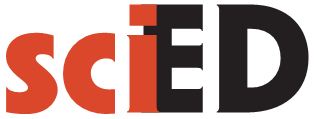Abstract
Studies over the past decade have indicated that Czech pupils do not have an appropriate level of mathematics comprehension and their attitudes towards this subject deteriorate over time. The article deals with a possible solution to the described problem; namely the implementation of peer instruction, an active learning strategy, in elementary mathematics teaching. In order to decide whether it is possible to use peer instruction as a teaching method in an elementary school environment, action research project with the properties of a mixed empirical study was performed in one eighth grade class (thirty participants) at a Czech multi-year grammar school. The main idea was to compare the results of the class before, during, and after the implementation of peer instruction. The pupils’ level of understanding was monitored by normalized learning gains calculated on the basis of pre/post-testing design. Changes in the pupils’ attitudes towards mathematics were mapped using continuous and pre/post-test questionnaires. In the spirit of the action research, interim data and results were regularly discussed with a group of selected pupils or experts in the field. The results show that there is a strong relationship between normalized learning gain and one of four typical roles with which pupils identify during group discussions: passengers, standard discussants, advisors, and dominant speakers. The research has also indicated that peer instruction needs to be appropriately modified to increase the passengers’ activity.
References
Balta, N., Michinov, N., Balyimez, S., & Ayaz, F.M. (2017). A meta-analysis of the effect of peer instruction on learning gain: Identification of informational and cultural moderators. International Journal of Educational Research, 86, 66–77. https://doi.org/10.1016/j.ijer.2017.08.009
Chen, Y.F., Liu, C. C., Yu, M.H., Chang, S.B., Lu, Y.C., & Chan, T.W. (2005). Elementary science classroom learning with wireless response devices implementing active and experiential learning. In IEEE International Workshop on Wireless and Mobile Technologies in Education (WMTE’05) (pp. 96–103). IEEE. https://doi.org/10.1109/WMTE.2005.22
Chien, Y.T., Chang, Y.H., & Chang, C.Y. (2016). Do we click in the right way? A meta-analytic review of clicker-integrated instruction. Educational Research Review, 17, 1–18. https://doi.org/10.1016/j.edurev.2015.10.003
Chvál, M. (2013). Změna postojů českých žáků k matematice během školní docházky [Changing attitudes of Czech pupils towards mathematics during school attendance]. Orbis scholae, 7(3), 49–71. https://doi.org/10.14712/23363177.2015.13
Crouch, C.H., & Mazur, E. (2001). Peer instruction: Ten years of experience and results. American journal of physics, 69(9), 970–977. https://doi.org/10.1119/1.1374249
Freeman, S., Eddy, S. L., McDonough, M., Smith, M.K., Okoroafor, N., Jordt, H., & Wenderoth, M. P. (2014). Active learning increases student performance in science, engineering, and mathematics. Proceedings of the National Academy of Sciences, 111(23), 8410–8415. https://doi.org/10.1073/pnas.1319030111
Garcia-Souto, M.P. (2020). Assessing and giving feedback to students working in teams: A staff perspective of the IPAC assessment methodology, In L.G. Chova, A. L. Martínez, & I.C. Torres (Eds.), INTED2020 Proceedings (pp. 4416–4416). IATED. https://doi.org/10.21125/inted.2020
Hake, R.R. (1998). Interactive-engagement versus traditional methods: A six-thousand-student survey of mechanics test data for introductory physics courses. American Journal of Physics, 66(1), 64–74. https://doi.org/10.1119/1.18809
Hallouin, I.A., & Hestenes, D. (1985). The initial knowledge state of college physics students. American Journal of Physics, 53(11), 1043–1055. https://doi.org/10.1119/1.14030
Lucas, A. (2009). Using peer instruction and i-clickers to enhance student participation in calculus, PRIMUS, 19(3), 219–231. https://doi.org/10.1080/10511970701643970
Mazur, E. (1997). Peer instruction: A user’s manual. Prentice Hall.
Mazur, E. (2009). Farewell, lecture. Science, 323(5910), 50–51. https://doi.org/10.1126/science.1168927
Mertler, C.A. (2019). Action research: Improving schools and empowering educators. SAGE Publications, Incorporated.
Michinov, N., Morice, J., & Ferri`eres, V. (2015). A step further in Peer Instruction: Using the Stepladder technique to improve learning. Computers & Education, 91, 1–13. https://doi.org/10.1016/j.compedu.2015.09.007
Olpak, Y. Z., Baltaci, S., & Arican, M. (2018). Investigating the effects of peer instruction on preservice mathematics teachers’ achievements in statistics and probability. Education and Information Technologies, 23(6), 2323–2340. https://doi.org/10.1007/s10639-018-9717-3
Pavelková, I., & Hrabal, V. (1988). Jaký jsem učitel?: Metody získávání poznatků o vlastní vzdělávací činnosti [What kind of teacher am I?: Methods of gaining knowledge about my own educational activities]. Státní pedagogické nakladatelství.
Pilzer, S. (2001). Peer instruction in physics and mathematics. PRIMUS, 11(2), 185–192. https://doi.org/10.1080/10511970108965987
Pöschl, R. (2005). Vnímání významu matematiky a fyziky středoškolskými studenty [Perception of the meaning of mathematics and physics by high school students]. [Diploma thesis. Charles University.] https://kdf.mff.cuni.cz/vyzkum/materialy/vnimani vyznamu M a F.pdf
Prince, M. (2004). Does active learning work? A review of the research. Journal of Engineering Education, 93(3), 223–231. https://doi.org/10.1002/j.2168-9830.2004.tb00809.x
Smith, M.K., Wood, W.B., Adams, W.K., Wieman, C., Knight, J.K., Guild, N., & Su, T.T. (2009). Why peer discussion improves student performance on in-class concept questions. Science, 323(5910), 122–124. https://doi.org/10.1126/science.1165919
Vickrey, T., Rosploch, K., Rahmanian, R., Pilarz, M., & Stains, M. (2015). Based implementation of peer instruction: A literature review. CBE – Life Sciences Education, 14(1), es3. https://doi.org/10.1187/cbe.14-11-0198
Vondrová, N., Rendl, M., Havlíčková, R., Hříbková, L., Páchová, A., & Žalská, J. (2015). Kritická místa matematiky základní školy v řešeních žáků [Critical points of elementary school mathematics in pupils’ solutions]. Karolinum.
Zadražil, T. (2020). Relationship between normalized learning gains of individuals and their typical role in group discussions with peers. In L. G. Chova, A. L. Martínez, & I. C. Torres (Eds.), INTED2020 Proceedings (pp. 3218–3227). IATED. https://doi.org/10.21125/inted.2020
Authors who publish with this journal agree to the following terms:
- Authors retain copyright and grant the journal right of first publication with the work simultaneously licensed under a Creative Commons Attribution License that allows others to share the work with an acknowledgement of the work's authorship and initial publication in this journal.
- Authors are able to enter into separate, additional contractual arrangements for the non-exclusive distribution of the journal's published version of the work (e.g., post it to an institutional repository or publish it in a book), with an acknowledgement of its initial publication in this journal.
- Authors are permitted and encouraged to post their work online (e.g., in institutional repositories or on their website) prior to and during the submission process, as it can lead to productive exchanges, as well as earlier and greater citation of the published work (See The Effect of Open Access).
